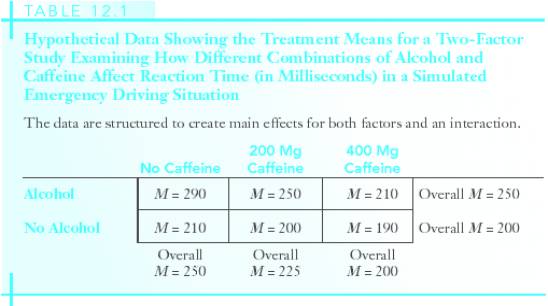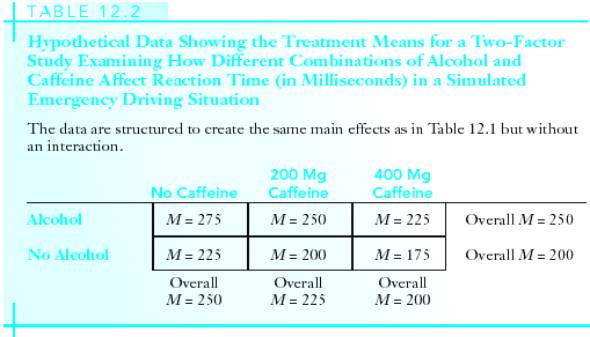I. Introduction
factorial design--two or more independent variables (or factors) are combined into a single study
A notation system is used to convey the number of factors and the number of levels that exist for each factor
Consider
the following example:

Figure
12.1 The Structure of a Two-Factor
Experiment Where Alcohol Consumption (the 1st factor or factor A) and Caffeine
Consumption (the 2nd factor or factor B) are Manipulated in the Same Study (p.
293)
How many levels of factor A? How many levels of factor B?
Therefore, this is a __ x __ design.
Why not do two separate studies, each investigating one of the independent variables?
Ask: How does alcohol consumption affect reaction time? or How does caffeine consumption affect reaction time?
Advantages of factorial designs:
(1) less artificial than single-factor designs
(2) enable us to access how IVs interact or combine to influence behavior differently than when considered separately
Can instead ask: How do changes in caffeine consumption influence the effects of
alcohol on behavior? or How do changes in alcohol consumption influence the
effects of caffeine on behavior?
II. Main Effects & Interactions
Main effect--the mean differences among the levels of one factor
To assess the main effects for alcohol, which numbers will be compared? Addresses what question?
To assess the main effects for caffeine, which numbers will be compared? Addresses what question?
But is there an alcohol x caffeine interaction? Do the differences between the cells in the matrix (the treatment combination means) show effects that are different from the overall main effects?
Interaction--the unique effects produced by two factors working together

Table
12.1 Hypothetical Data Showing the
Treatment Means for a Two-Factor Study Examining How Different Combinations of
Alcohol and Caffeine Affect Reaction Time (in msec) in a Simulated Emergency
Driving Situation (p. 296)

**How do we describe this interaction in words?

Table
12.2 Hypothetical Data Showing the
Treatment Means for a Two-Factor Study Examining How Different Combinations of
Alcohol and Caffeine Affect Reaction Time (in msec) in a Simulated Emergency
Driving Situation (p. 298)

Figure
12.3 A Line Graph of the Data from
Table 12.2 (p. 301)

Figure
12.5 Three Possible Combinations of
Main Effects and Interactions in a Two-Factor Experiment
(p. 304)